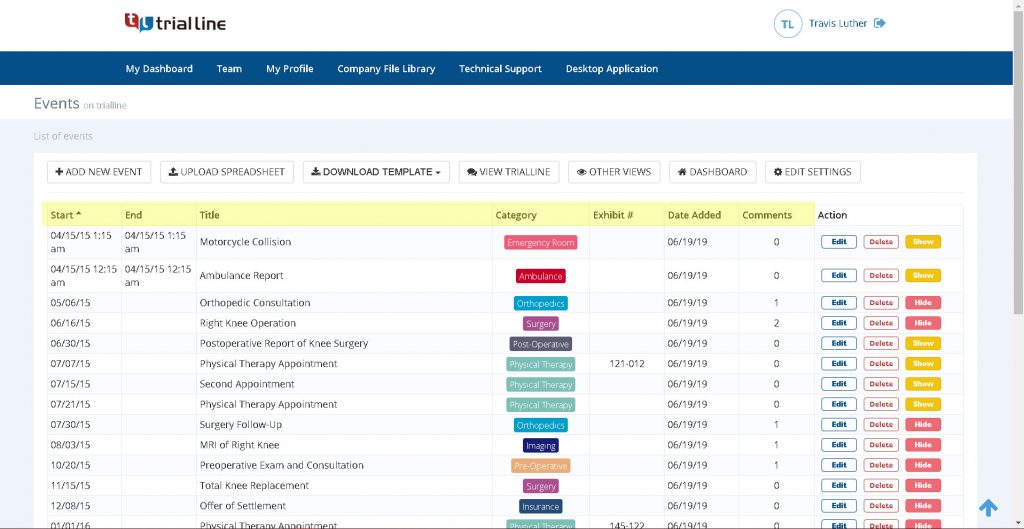Courts depend on clear evidence to make fair decisions. However, traditional methods, such as printed documents and physical exhibits, often slow down proceedings and create confusion.
Lawyers who implement an evidence presentation system can present cases more clearly so that judges and juries can easily follow the facts.
These systems use digital tools to allow lawyers to present documents, images, videos, and other evidence in a structured way.
This article explains how they work, their benefits, and their role in modern trials.
Build persuasive arguments with clear timelines—use TrialLine!
What Is an Evidence Presentation System?
An evidence presentation system is a digital tool that transforms how lawyers present evidence in court.
These systems replace traditional paper documents with digital displays, allowing attorneys to deliver faster and more effective presentations. They can quickly display key documents, mark important details, and transition between various types of evidence without losing momentum.
Secure digital storage and remote access also ensure that legal teams can retrieve and manage case materials efficiently from any location.
Components of Evidence Presentation Systems
Modern presentation systems help lawyers present case materials clearly, ensuring smooth court proceedings:
- Display screens and monitors – High-resolution screens at the judge’s bench, witness stand, and counsel tables provide clear visibility.
- Document cameras – Display physical documents, handwritten notes, and exhibits in real time.
- Digital media players – Support video and audio evidence, including surveillance footage and recorded statements. Meanwhile, a control panel is used to switch video sources.
- Interactive touch screen monitors – Placing touch screen monitors at the witness and attorney tables enables real-time document annotation and highlighting of key details.
- Wireless presentation equipment – Enable counsels to present materials without cables.
Make legal presentations smoother—get TrialLine now!
Benefits of Advanced Evidence Presentation Systems
Modern presentation systems improve how legal teams manage and present case materials. For example:
- Enhanced clarity and persuasiveness – Helps jurors and judges understand key points through digital markups, interactive displays, and clear visual aids.
- Increased efficiency – Keeping all case materials in one place reduces courtroom delays. This allows attorneys to quickly access and present evidence without searching through stacks of paper.
- Improved organization and accessibility – Stores case materials in a categorized and searchable format. It also eliminates the risk of misplaced evidence and ensures quick retrieval of key documents.
- Enhanced security and confidentiality – Protects sensitive legal information with encryption and access controls. It further prevents unauthorized access, data loss, and tampering.
How Lawyers Can Adopt Evidence Presentation Systems
As courtroom technology continues to evolve, legal professionals need to stay updated on the best ways to incorporate digital tools into their practice.
Successfully implementing these systems requires:
Training and Adaptation
To maximize the benefits of an evidence presentation system, you should learn how to use it effectively.
Training sessions help attorneys navigate presentation tools, access case materials instantly, and highlight key evidence using interactive features. Mastery of these systems allows you to deliver more compelling arguments and keep jurors engaged.
Continuous practice and hands-on experience will help you stay comfortable with evolving technology and avoid technical setbacks during trials.
Cost Considerations
Upfront costs vary based on the system’s features, hardware, and trial software requirements.
While some solutions require huge investments, they reduce long-term expenses by cutting down on paper-based processes, minimizing trial delays, and improving efficiency.
Assess your budget and choose a system that meets your needs without unnecessary expenses.
A well-chosen evidence presentation system improves efficiency and strengthens a lawyer’s ability to present persuasive, well-organized arguments in court.
Improve Your Evidence Presentation With TrialLine
TrialLine transforms how attorneys manage and present cases by providing a structured, event-by-event timeline.
It allows you to create customized legal timelines that clearly communicate key case details. Events are displayed in an easy-to-follow format, offering a complete view of case progression.
With TrialLine, lawyers can organize large amounts of evidence, including documents, images, videos, and other multimedia files.
Everything is logically categorized, making case materials easy to retrieve and present.
Strengthen your legal presentations—schedule a demo with TrialLine now!
FAQs About Evidence Presentation System
What is evidence presentation?
Evidence presentation is the process of displaying and explaining case materials, such as documents, images, videos, and other supporting information, to support an argument or decision-making process. It is commonly used in legal settings, academic research, business reports, and scientific studies to provide clear, structured, and persuasive information.
How do you present evidence in a presentation?
Evidence should be presented in a logical and organized manner, using visuals, structured formats, and clear explanations. Key materials can be displayed through slides, charts, timelines, or multimedia to enhance understanding. The presenter should introduce the evidence, explain its relevance, and connect it to the overall argument. Engaging visuals and structured sequencing help keep the audience focused and make the information easier to process.
How should evidence be presented?
Evidence should be clear, relevant, and well-organized. It should be introduced with context, followed by an explanation of how it supports the argument. Visual aids such as charts, graphs, and digital displays help simplify complex details.
What is a presentation of evidence in a project?
In a project, evidence presentation involves organizing and displaying supporting data, research findings, or case studies to justify conclusions or recommendations. This can be done through reports, slideshows, or visual demonstrations. The evidence should be structured logically, cited properly, and clearly linked to the project’s objectives to strengthen its credibility and effectiveness.






